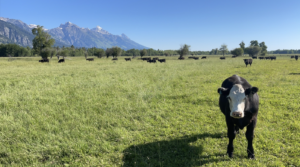Calling in the Cattle
#bfrdpwy #aginternship #RightRisk

This week, hoof rot continued to hit our heifers hard. The flood irrigation is not forgiving in terms of prevention or recovery of infection. I would say we are doctoring an average of 12 heifers a day, and we are only targeting the critical ones at the moment. We had a heifer this week that was too weak to move more than a walk and would fall down every 100 feet or so. We couldn’t get our trailer out to where she was, so we brought out a side by side, rolled her onto four t-posts and used eight of us to lift her into the bed of it. She went to a drier lot near our headquarters so we can keep a better eye on her.

The heifers are starting to really respond to us calling them when we rotate pastures, which is very important come shipping time, as they will have to cross a huge, main road. We can get about 80% of the heifers through the gate by just calling them, and then we go in with horses and gather up the rest. The steers can be moved almost fully by calling at this point as well.

The concept of “calling” cows is not something I was familiar with before I came to this ranch, but I now am fully on board. It’s hard to write the sounds you make, but the idea is that it sounds like a mother cow, and they come running to it. They can also be trained with it like dogs, in the sense that every time you move them to better pasture, or put out supplement, or really anything positive in their eyes, you call and eventually they just learn to come to it. It’s a great skill to have in your arsenal.
Something I would challenge in the ranching industry this week is for ranches to continue to use horses as much as possible. Although you can do a decent job of moving or gathering cattle on a four-wheeler, there is no comparison to the intellect and instinct of a good cowhorse. They work with you instead of against you and their sense for cattle is unmatched.

My biggest takeaway from this week would be that although cattle can be chaotic and illogical sometimes, the most important part of working them is remaining calm and slow. Putting only as much pressure on the herd as is absolutely necessary pays off immensely in the long run. Slowing down and making deliberate, intentional movements saves you a lot of headache.
Submitted by: Isabella Schultz
Edits by: GrowinG Internship Team

